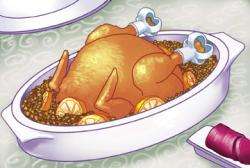How to cook the perfect turkey (the scientific way)

For most people, the key to preparing the perfect Christmas meal is cooking the turkey. University of Bristol physicist, Dr Peter Barham explains how applying scientific principles in the kitchen at Christmas can help you achieve the perfect festive fowl.
Meat consists of muscle fibres, connective tissues and fats. The muscle fibres largely consist of two proteins, myosin and actin. When muscle fibres are heated above about 40ºC the proteins start to denature, the resulting change of shape involves the proteins coiling up. This coiling process inevitably causes some contraction of the muscle.
As meat is cooked, so heat flows in and more proteins are denatured. The denatured proteins shrink making the meat progressively tougher. Thus the longer you cook any meat the 'tougher' the muscle fibres will become.
The connective tissues (collagen, reticulin and elastin) that join the muscles to the bone and wrap around the muscle fibre bundles, are too tough for us to bite through (and remain largely indigestible) before they are heated. However, after prolonged heating to a temperature above 60ºC the collagen triple helices are destroyed and tough collagen becomes soft gelatin. Accordingly there must be a compromise between overheating the muscle fibres and producing a tough product, and not heating enough to denature the collagen, which would again leave tough meat.
The remaining important components of meat are fats and water. In fact most of the turkey (about 60%) is water, making it the largest single component. When meat is cut some water flows out and the meat becomes a little wet. However, most of the water in a piece of meat remains bound to the proteins. When proteins are denatured some of this bound water can escape. You can see this when you fry meat; after a short cooking time, some liquid (mostly water) will start to flow out of the meat and as it boils in the hot fat it ‘spits’ at you. If significant amounts of water are lost in this way the cooked meat will seem dry.
Once you have managed to produce the right moist and tender texture you will still have to obtain the perfect flavour. By far the largest component of flavour is the aroma (detected in the nose), rather than the taste (detected in the mouth); so flavour is dominated by small volatile molecules.
Cooking proteins generates lots of new small volatile molecules. The ones we recognise as having "meaty" aromas are mostly generated through a series of reactions between proteins and sugars known collectively as the Maillard reactions. The chemistry is to say the least complex - people have devoted their entire lives to trying to unravel a small part of the possible reactions. Fortunately, you don't need to know much about the overall reaction scheme. The important reactions that generate the cooked turkey flavour only really start at a respectable rate above about 140°C, but if the temperature exceeds 200°C then different reactions leading to bitter and even carcinogenic compounds can set in.
Putting all this together you can see you will need to make a series of compromises to cook a "perfect" turkey. The outside needs to be heated to between 140 and 200 °C to make sure the Maillard reactions provide plenty of the "Turkey" flavour for the gravy. The tender breast meat wants to be heated to no more than 55 to 58°C to keep the muscle proteins from contracting and becoming tough. The tougher, collagen rich, legs and wings need to be heated to a higher temperature (say around 65 to 70°C) to denature some of the collagen.
There are as many different approximate solutions as there are cookery writers. The simplest is of course to bone the turkey and cook the different parts separately. This is fine in a restaurant where you simply put the carved meat on the plate, but at home you want to put a cooked turkey on a plate and carve it in front of the family. My own favoured cooking method is to cover the more delicate breasts with aluminium foil to keep them from getting too hot as the wings and legs cook and only remove this foil towards the end of the cooking. To reduce the evaporation of water and to improve heat transfer I cook in a moist oven (keeping stock under the turkey as it cooks).
You need to heat to the meat to as near as possible to the ideal temperatures mentioned above, but how long should you cook the turkey?
The oven will of course be at a higher temperature (say 160°C) than the turkey so there will always be a temperature gradient - the turkey will be ready when the parts furthest from the outside reach the desired temperature.
Solving the thermal diffusion equations for the ideal spherical turkey shows that the cooking time depends linearly on the temperature difference between the oven and the uncooked turkey and also on the square of the radius of the bird. To sort that one out just ask a physicist.
A simpler, and more practical approach is to use a probe to measure the temperature inside the different parts of the bird so that you can control when to take off the foil and when to take the turkey out of the oven.
Once you’ve cracked the turkey, of course, you still need to worry about the vegetables, the gravy, the stuffing and of course the pudding before you can rest on your laurels as a chemist!
Source: University of Bristol















